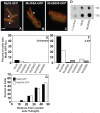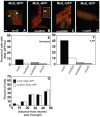Beta clamp directs localization of mismatch repair in Bacillus subtilis
- PMID: 18280235
- PMCID: PMC2350196
- DOI: 10.1016/j.molcel.2007.10.036
Beta clamp directs localization of mismatch repair in Bacillus subtilis
Abstract
MutS homologs function in several cellular pathways including mismatch repair (MMR), the process by which mismatches introduced during DNA replication are corrected. We demonstrate that the C terminus of Bacillus subtilis MutS is necessary for an interaction with beta clamp. This interaction is required for MutS-GFP focus formation in response to mismatches. Reciprocally, we show that a mutant of the beta clamp causes elevated mutation frequencies and is reduced for MutS-GFP focus formation. MutS mutants defective for interaction with beta clamp failed to support the next step of MMR, MutL-GFP focus formation. We conclude that the interaction between MutS and beta is the major molecular interaction facilitating focus formation and that beta clamp aids in the stabilization of MutS at a mismatch in vivo. The striking ability of the MutS C terminus to direct focus formation at replisomes by itself, suggests that it is mismatch recognition that licenses MutS's interaction with beta clamp.
Figures






Similar articles
-
Trapping and visualizing intermediate steps in the mismatch repair pathway in vivo.Mol Microbiol. 2013 Nov;90(4):680-98. doi: 10.1111/mmi.12389. Epub 2013 Sep 16. Mol Microbiol. 2013. PMID: 23998896
-
Recurrent mismatch binding by MutS mobile clamps on DNA localizes repair complexes nearby.Proc Natl Acad Sci U S A. 2020 Jul 28;117(30):17775-17784. doi: 10.1073/pnas.1918517117. Epub 2020 Jul 15. Proc Natl Acad Sci U S A. 2020. PMID: 32669440 Free PMC article.
-
Mismatch repair causes the dynamic release of an essential DNA polymerase from the replication fork.Mol Microbiol. 2011 Nov;82(3):648-63. doi: 10.1111/j.1365-2958.2011.07841.x. Epub 2011 Sep 30. Mol Microbiol. 2011. PMID: 21958350 Free PMC article.
-
Mismatch repair in Gram-positive bacteria.Res Microbiol. 2016 Jan;167(1):4-12. doi: 10.1016/j.resmic.2015.08.006. Epub 2015 Sep 3. Res Microbiol. 2016. PMID: 26343983 Review.
-
Mismatch binding, ADP-ATP exchange and intramolecular signaling during mismatch repair.DNA Repair (Amst). 2016 Feb;38:24-31. doi: 10.1016/j.dnarep.2015.11.017. Epub 2015 Dec 2. DNA Repair (Amst). 2016. PMID: 26704427 Free PMC article. Review.
Cited by
-
Clp and Lon proteases occupy distinct subcellular positions in Bacillus subtilis.J Bacteriol. 2008 Oct;190(20):6758-68. doi: 10.1128/JB.00590-08. Epub 2008 Aug 8. J Bacteriol. 2008. PMID: 18689473 Free PMC article.
-
Postreplicative mismatch repair.Cold Spring Harb Perspect Biol. 2013 Apr 1;5(4):a012633. doi: 10.1101/cshperspect.a012633. Cold Spring Harb Perspect Biol. 2013. PMID: 23545421 Free PMC article. Review.
-
Functional analyses of Escherichia coli MutS-beta clamp interaction in vitro and in vivo.Curr Microbiol. 2010 Jun;60(6):466-70. doi: 10.1007/s00284-009-9566-9. Epub 2009 Dec 23. Curr Microbiol. 2010. PMID: 20033171
-
DNA mismatch repair in eukaryotes and bacteria.J Nucleic Acids. 2010 Jul 27;2010:260512. doi: 10.4061/2010/260512. J Nucleic Acids. 2010. PMID: 20725617 Free PMC article.
-
Transposition into replicating DNA occurs through interaction with the processivity factor.Cell. 2009 Aug 21;138(4):685-95. doi: 10.1016/j.cell.2009.06.011. Cell. 2009. PMID: 19703395 Free PMC article.
References
-
- Acharya S, Foster PL, Brooks P, Fishel R. The coordinated functions of the E. coli MutS and MutL proteins in mismatch repair. Mol Cell. 2003;12:233–246. - PubMed
-
- Beuning PJ, Sawicka D, Barsky D, Walker GC. Two processivity clamp interactions differentially alter the dual activities of UmuC. Mol Microbiol. 2006;59:460–474. - PubMed
-
- Biswas I, Hsieh P. Identification and characterization of a thermostable MutS homolog from Thermus aquaticus. J Biol Chem. 1996;271:5040–5048. - PubMed
Publication types
MeSH terms
Substances
Grants and funding
LinkOut - more resources
Full Text Sources
Other Literature Sources

